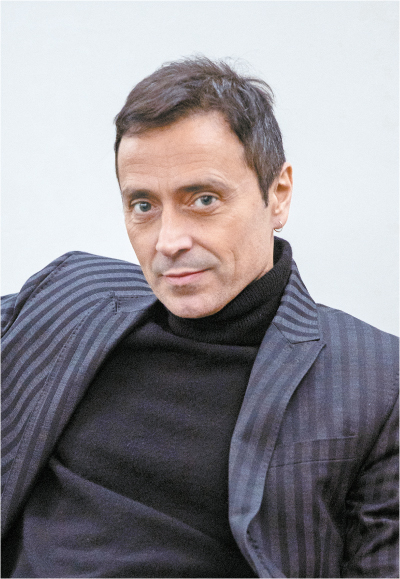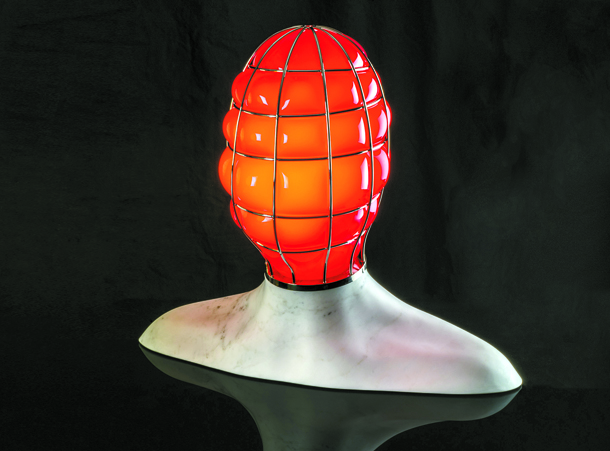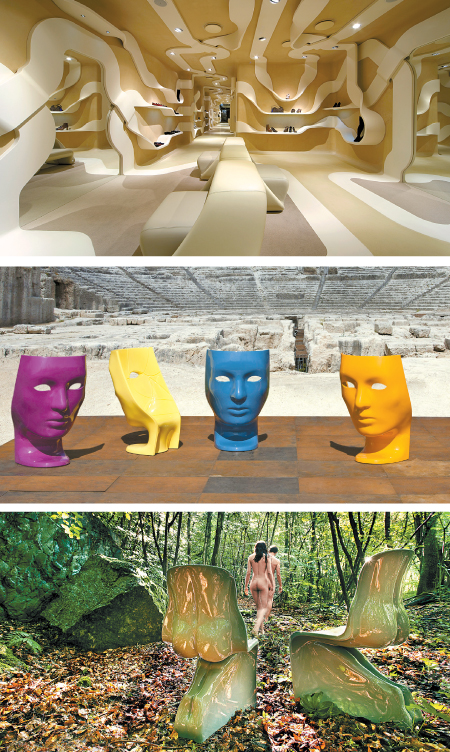Fabio Novembre gets inspired by obsession: Renowned Italian designer and architect talks creativity and truth

“For me, obsession is an access key,” he said during the design seminar at the Seoul Design Festival on Friday. “I was born obsessed - it’s like walking, breathing and heart pumping. [Although] obsession is something that can make you crazy, it’s a fantastic driver if you can control it.”
Novembre is one of those people who knows how to control his obsession and turn it into something that people call “a masterpiece.” Most of his work was born out of an obsession over something - whether that is love, a person or a philosopher’s thoughts.
A phrase that he has kept in his resume for over 20 years reads: “I want to breathe till I choke. I want to love till I die.” Throughout his career as a designer, he has remembered to tell himself not to betray his original intention, which is to “live the most complete feeling until the day I die.”
The Korea JoongAng Daily met with the artist after the seminar to discuss his life and his works. The following are edited excerpts from the interview.

The Muse lamp (top) for glass art company Venini (2016). [DOMUS ACADEMY]
A. When I took a degree in architecture in 1992 [in Milan], I had a very big problem - I couldn’t draw. I couldn’t sketch. But I was always able to focus on what I wanted. But no studio had taken me [at that time] because I couldn’t draw - so I thought, what is my other huge passion? Cinema. So I went to New York [in 1993] to study movie direction. But, a year and a half after, I met Anna Molinari, an Italian fashion designer [who] gave me my first assignment, which was [designing] a fashion shop for her. So I left everything and I moved to Hong Kong [for the job] - there, I could mix my architecture background knowledge and what I learned in New York about movies. It was like finding myself in the right context. And I realized, I could be an architect even if I couldn’t draw. I told myself, ‘You’re good. You can do spaces.’ I could receive the harmony, the surface and the volumes. That’s something you don’t learn in school. You have to be in [the] field in order to understand.
You come from Lecce, a baroque city. How has this art style affected some of your early works, like designing the Stuart Weitzman store?
I thought I denied my past, but in the end I realized [that] I cannot always deny my past. It’s always there. There’s a saying that goes, ‘Dust from your hometown is always in your shoes.’ Even if I was out of my hometown for such a long time, my [early] years were so full of meaning. It was only after when I saw my project, Stuart Weitzman, that I [felt] so connected to the baroque city. The decorations - the maximalism - what I always had inside was just coming out.
[On the contrary,] I try to achieve a very simple result. I’m colorful, decorative, visually powerful, and so on, but I try to make simple messages that go straight to the heart of people. I want love at first sight. If you go deeper into my works, you can find all of the symbolism, all the complicated things that I hide, but first of all, I want people to [look at my works and say,] ‘Wow.’
It’s hard to define your works in simple words because it seems like you have been inspired by a lot of sources - from history to your heroes and just about anything. Tell us about some of your major sources of inspiration.
Looking at women all your life is never enough - it’s always like the first time. I have a girlfriend now, and [when] we lie in bed, I can just look at her forever. That’s what really inspires me. I find so much harmony in that. It’s like looking at her for the first time. When I see her naked body, I see so much harmony in it because I see life: I see continuity and eternity.
(Referring to his work ‘Him & Her chair’) It’s an homage to the naked body. I’m [also] obsessed with nudity for a very simple reason. When you read the Bible, there’s a line saying: ‘Adam and Eve were naked and they didn’t have any sense of shame.’ The whole sense of shame comes with the original sin - so the original sin makes them feel shamed. So they start covering. I hate all that. I want to go to human beings before the original sin. That’s why I want to live like Adam and Eve. I want to be kicked out from Paradise.

From left, a store of U.S. shoe brand Stuart Weitzman located in Rome (2006), the Nemo chair for Italian brand Driade (2010), the Him & Her chairs for Italian furniture brand Casamania (2008) [DOMUS ACADEMY]
‘Nemo’ means ‘no-one’ in Latin. [My objective was to] create a face that is not Asian, not Western, not female nor male. [It was to make] something that could be used by anyone. When you are no-one, you can be anyone. It’s a mask that everyone can use in order to tell the truth. As Oscar Wilde said, ‘Wear a mask, and you will tell the truth.’
We see a lot of “cliched designs” - or rather, “fake creativity” - in the modern world. But a vital part of any design is creativity, and many of your works appear to be very creative. What is your own definition of creativity?
[Creativity is about exploring.] When you explore a forest, if you choose a path already explored before, it’s comfortable and you may think, ‘I’m exploring.’ But no, you’re not. You are going after the path of someone else. Exploring means taking a machete and cutting through the forest and making your own path: it’s difficult, risky and [tiring]. If you want to be an explorer, you have to understand that it will take a lot of effort and energy.
Many students studying design face difficulties in producing “originality” or “creativity” in their works. Do you have any advice or tips for them?
I used to have the same difficulty and problem. It has also been difficult for me. But now, with all the 3D programs on computers, you can actually do a full project of everything - you can see it from all 360 degrees, you can render it in a way that looks real, and you can put it on web platforms. It looks like you actually did it. It was impossible for me to do something like that because I had to prototype, but it would never look like a real prototype. You can do beautiful things even if they are unreal and show them in the market so you can advertise in there. I would tell them, don’t be desperate - use the tools that modernity gives you.
What are your own future goals as a designer?
I’m a designer of the present. We don’t have to look backward or forward. If I go on thinking about the future, I would not concentrate on the fact that I’m talking with you now.
When I go to my studio in the morning, I say, ‘Okay guys, what do we have to do today?’ If you ask me where I will go in January, I don’t know. I want to keep a level of enthusiasm that only comes with keeping your mind free. I don’t want to know too much. I want to live every day as if it’s a really new day. If I know [my agenda] before, I get anxious. Today is today.
BY YEO YE-RIM [yeo.yerim@joongang.co.kr]










with the Korea JoongAng Daily
To write comments, please log in to one of the accounts.
Standards Board Policy (0/250자)